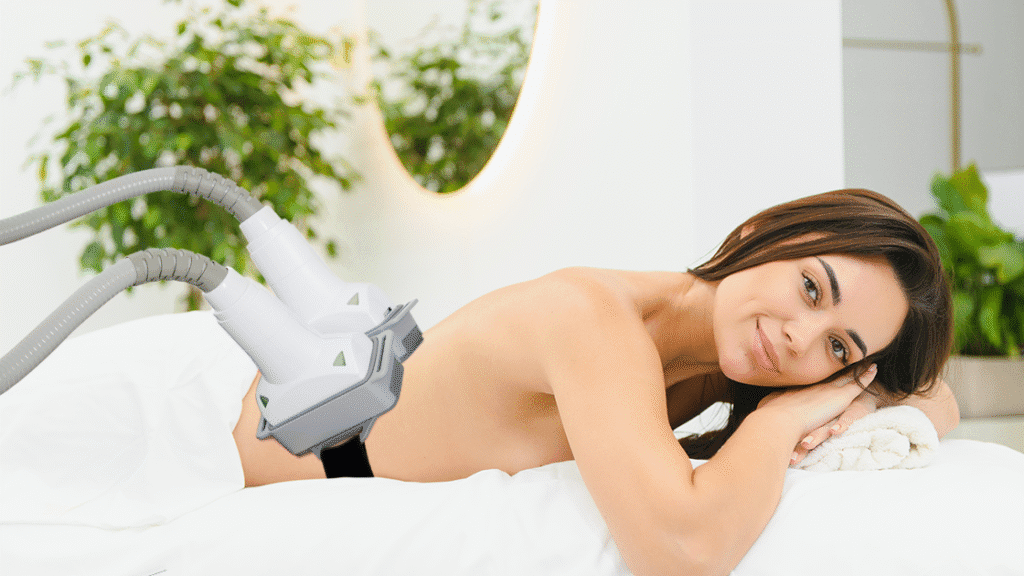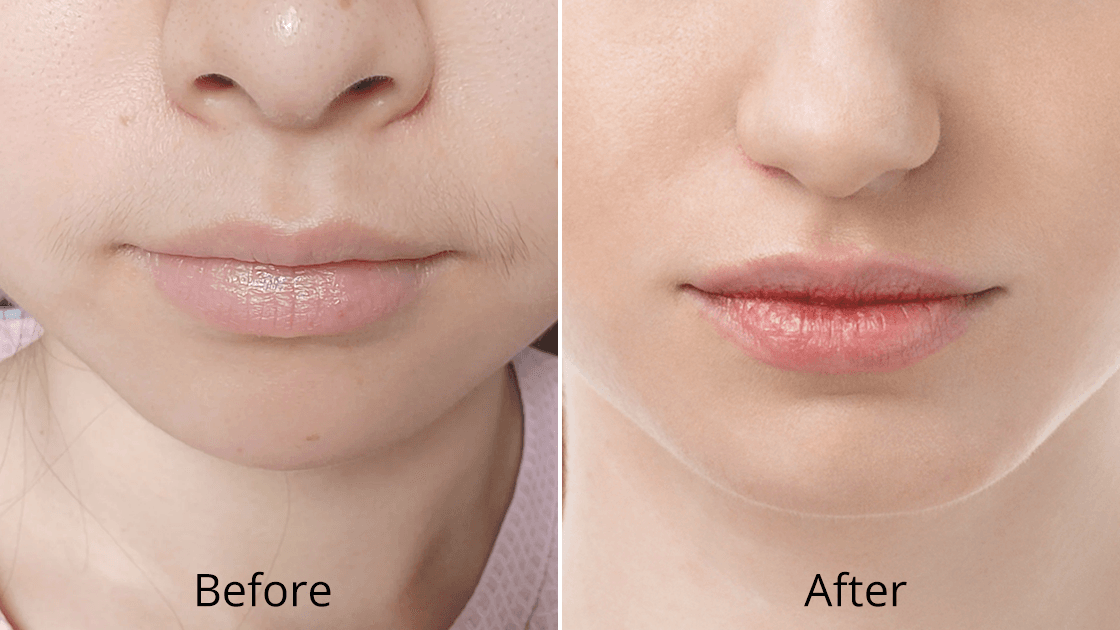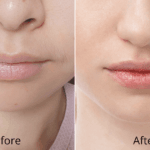1. Introducción
In the pursuit of an ideal body contour, many individuals find themselves battling persistent fat deposits that seem impervious to even the most dedicated fitness regimens and dietary modifications. Among the most challenging areas to address are the lower back and flanks—commonly referred to as “love handles”—which represent some of the most stubborn fat deposits in the human body. These areas present unique physiological and anatomical challenges that conventional weight loss approaches often fail to adequately address, leading to frustration and discouragement among those seeking body contouring solutions.
1.1 Understanding Stubborn Fat: Lower Back and Flanks
The lower back and flank regions demonstrate distinct anatomical characteristics that contribute to their resistance to conventional fat reduction methods. These areas contain predominantly subcutaneous adipose tissue with higher concentrations of alpha-2 adrenergic receptors, which inhibit lipolysis and promote fat storage. This pinchable fat of your love handles and lower back is likely subcutaneous fat that sits just under the skin. The vascular supply to these regions is relatively limited compared to other body areas, resulting in reduced metabolic activity and slower fat mobilization. Additionally, hormonal factors, particularly cortisol and insulin, preferentially promote fat accumulation in these areas during periods of stress or metabolic dysfunction, creating a challenging cycle of fat deposition and retention.
1.2 Why Traditional Methods Sometimes Fail
Neither diet nor exercise will equate to spot losing back fat due to the physiological nature of fat metabolism and the specific characteristics of adipose tissue in these regions. Traditional approaches including cardiovascular exercise, strength training, and caloric restriction work through systemic fat mobilization, but the body determines fat loss patterns based on genetic predisposition, hormonal influences, and receptor distribution rather than targeted exercise efforts. The lower back and flanks often remain resistant to these approaches due to their higher concentration of alpha-2 adrenergic receptors, which actively inhibit fat breakdown, and reduced blood flow compared to more metabolically active regions. Even individuals who achieve significant overall weight loss may retain stubborn fat deposits in these areas, highlighting the limitations of conventional approaches.
1.3 How Laser Lipolysis Offers a Modern Solution
Laser lipolysis represents a revolutionary advancement in contorno corporal technology, utilizing targeted light energy to directly address the physiological barriers that make lower back and flank fat so resistant to traditional methods. This innovative approach employs specific wavelengths of laser light, typically in the 1064nm range, to penetrate subcutaneous tissues and directly interact with adipocytes (fat cells) through photomechanical and photothermal mechanisms. Unlike systemic approaches that rely on the body’s natural fat mobilization processes, laser lipolysis creates controlled thermal effects that disrupt adipocyte membranes, stimulate lipolysis, and promote the release of stored triglycerides. This targeted approach allows practitioners to address specific problem areas with precision, overcoming the physiological limitations that make these regions resistant to diet and exercise alone.
1.4 Key Benefits Overview
The advantages of laser lipolysis for lower back and flank fat reduction extend beyond simple fat removal, encompassing a comprehensive approach to body contouring and aesthetic improvement. Primary benefits include precise targeting of treatment areas without affecting surrounding tissues, non-invasive treatment protocols that eliminate surgical risks and extended recovery periods, and concurrent skin tightening effects through collagen stimulation and tissue remodeling. It’s much less painful, though, and laser lipolysis recovery is also shorter and less complicated compared to surgical alternatives. The technology enables practitioners to customize treatment parameters based on individual patient characteristics, fat thickness, and aesthetic goals, optimizing outcomes while minimizing side effects. Long-term results demonstrate sustainable fat reduction when combined with appropriate lifestyle modifications, making it an effective solution for individuals seeking permanent improvement in these challenging areas.
2. What is Laser Lipolysis?
Understanding the fundamental principles and mechanisms underlying laser lipolysis is essential for appreciating its effectiveness in addressing stubborn fat deposits. This advanced technology represents the convergence of laser physics, cellular biology, and aesthetic medicine to create a targeted approach to fat reduction that addresses the specific challenges presented by resistant adipose tissue.
2.1 Definition and Mechanism of Action
Laser lipolysis is a minimally invasive or non-invasive procedure that utilizes specific wavelengths of coherent light energy to selectively target and disrupt adipocytes while promoting natural fat metabolism and elimination processes. The treatment employs laser systems operating at wavelengths between 980nm and 1064nm, which demonstrate optimal absorption characteristics in adipose tissue while minimizing absorption in surrounding structures such as blood vessels, nerves, and connective tissue. The mechanism involves photomechanical and photothermal effects that create controlled micropores in adipocyte membranes, allowing stored triglycerides to be released into the interstitial space where they can be metabolized and eliminated through the lymphatic system and liver metabolism. Additionally, the thermal effects stimulate collagen synthesis and tissue remodeling, contributing to skin tightening and improved tissue texture in treated areas.
2.2 Difference Between Laser Lipolysis and Traditional Liposuction
The distinctions between laser lipolysis and traditional liposuction are fundamental, affecting everything from treatment approach to recovery expectations and long-term outcomes. Traditional liposuction is an invasive surgical procedure that mechanically removes fat through suction after tissue disruption with cannulas, requiring general anesthesia, significant recovery time, and carrying inherent surgical risks including infection, bleeding, and contour irregularities. Laser lipolysis is a non-invasive form of body sculpting that removes small fat deposits and is much less painful while offering shorter recovery times. Laser lipolysis achieves fat reduction through controlled cellular disruption and natural elimination processes, allowing for more precise contouring and reduced trauma to surrounding tissues. The laser approach also provides concurrent skin tightening benefits through collagen stimulation, addressing both fat reduction and skin laxity concerns simultaneously, which traditional liposuction cannot achieve without additional procedures.
2.3 Common Misconceptions About Laser Fat Removal
Several misconceptions persist regarding laser lipolysis technology and its capabilities, often leading to unrealistic expectations or hesitation among potential candidates. One common misconception is that laser lipolysis provides immediate results similar to surgical liposuction, when in reality the process involves gradual fat cell disruption and elimination over 6-12 weeks following treatment. Another frequent misunderstanding concerns the permanence of results, with some believing that treated fat cells can regenerate, when scientific evidence demonstrates that mature adipocytes cannot reproduce once destroyed. Some individuals mistakenly believe laser lipolysis can substitute for healthy lifestyle habits, failing to understand that optimal results require maintaining stable body weight and continuing appropriate diet and exercise practices. Additionally, there’s often confusion about treatment sensation and safety, with some expecting painful procedures when modern laser systems incorporate advanced cooling technologies and safety protocols that ensure comfortable, safe treatments with minimal risk of adverse effects.
3. Target Areas: Lower Back and Flanks
The anatomical complexity and physiological characteristics of the lower back and flank regions make them particularly challenging areas for fat reduction, yet highly suitable for laser lipolysis intervention. Understanding these specific characteristics is crucial for optimizing treatment approaches and setting appropriate expectations for both practitioners and patients.
3.1 Understanding “Love Handles” and Back Fat
The colloquial terms “love handles” and “back fat” refer to subcutaneous adipose deposits located in the posterior and lateral aspects of the torso, specifically encompassing the lumbar region and lateral trunk areas extending from the lower ribcage to the superior aspect of the iliac crest. These deposits consist primarily of subcutaneous fat characterized by larger adipocytes, higher concentrations of alpha-2 adrenergic receptors, and reduced vascularization compared to visceral fat or fat in more metabolically active regions. The anatomical distribution follows gender-specific patterns, with males typically accumulating fat in the lower back and posterior flanks, while females often develop deposits extending more laterally and anteriorly around the waistline. They indicate excess fat accumulation around the hips and abdominal area, creating characteristic contour irregularities that can significantly impact body silhouette and clothing fit, contributing to aesthetic concerns and reduced self-confidence.
3.2 Why These Areas Are Resistant to Exercise
Lower back and flank fat contain high levels of alpha-2 adrenergic receptors that block fat breakdown.
These receptors limit the effects of norepinephrine and epinephrine during exercise.
Even lean individuals may still struggle with stubborn fat in these zones.
The vascular supply in these regions is relatively poor, slowing fat mobilization.
Limited blood flow reduces delivery of fat-burning hormones and enzyme activity.
Fatty acid removal from these areas occurs at a much slower rate.
Blood circulation does not increase significantly here during workouts.
Significant overall body fat loss is often needed before visible slimming occurs.
3.3 How Fat Distribution Affects Body Contour
Fat accumulation in the flanks and lower back strongly influences body contour.
Excess fat often creates a “muffin top,” disrupting natural waistline definition.
Flank fat can make the hips appear wider and the waist less defined.
Posterior fat buildup contributes to a rounded or bulging lower back.
These changes affect body proportions and silhouette balance.
Clothing may fit poorly or uncomfortably due to excess fat in these areas.
Fat distribution can visually alter posture and make the midsection look heavier.
Many individuals report reduced self-confidence in fitted clothing.
3.4 Ideal Candidates for Laser Lipolysis in These Areas
Candidates should have a stable body weight within 15–20 pounds of their goal weight.
Individuals with a BMI of ≤30 are considered optimal for laser lipolysis.
Good skin elasticity is important to respond effectively to collagen stimulation.
Realistic expectations regarding treatment timelines and aesthetic outcomes are essential.
Medical conditions such as active infections, autoimmune diseases, pregnancy, or nursing are contraindications.
Certain medications that affect healing or increase photosensitivity should be avoided.
Candidates must be committed to maintaining results through regular exercise and balanced nutrition.
Laser lipolysis is intended for body contouring rather than significant weight loss.
Age 25–55 is ideal, with good overall health and adequate skin quality for optimal results.
4. Advantages of Laser Lipolysis Over Other Methods
The superiority of laser lipolysis compared to alternative fat reduction approaches becomes particularly evident when addressing the challenging lower back and flank regions, where traditional methods often prove inadequate or impractical. These advantages encompass treatment approach, recovery considerations, and long-term aesthetic outcomes.
4.1 Non-Invasive Approach
Laser lipolysis offers a major advantage over surgical procedures because it is non-invasive, avoiding the risks and downtime of traditional liposuction. Unlike surgery, which requires incisions, anesthesia, and mechanical tissue disruption, this treatment uses light-based technology that penetrates beneath the skin without breaking its surface. Patients avoid common surgical risks such as infection, bleeding, nerve injury, or irregular contours. Instead, laser lipolysis is performed with only topical comfort measures, making it safe and comfortable. The absence of surgical trauma reduces inflammation, minimizes discomfort, and eliminates the need for compression garments or wound care. Most individuals can resume their normal activities immediately after treatment, making it highly compatible with professional and social commitments. This combination of safety, convenience, and efficacy makes laser lipolysis a preferred choice for people seeking effective body contouring solutions without the recovery burden associated with invasive surgical methods.
4.2 Precision in Targeting Hard-to-Reach Fat
One of the key strengths of laser lipolysis is its ability to target fat with remarkable precision, especially in areas that are difficult to treat, such as the lower back and flanks. Advanced devices allow practitioners to control variables like depth of penetration, energy density, and coverage patterns based on each patient’s anatomy. This customization ensures accurate treatment of irregular fat deposits and variable thicknesses while sparing muscles, nerves, and surrounding tissues. Integrated safety systems, including real-time temperature monitoring, further enhance treatment accuracy by preventing overheating or tissue damage. This precision is especially valuable in sculpting the body’s natural contours, where small adjustments can produce significant aesthetic improvements. Compared to less targeted approaches, laser lipolysis provides predictable outcomes and greater patient satisfaction. The technology allows physicians to adapt treatment to individual needs, creating tailored results that align with personal goals while ensuring safety and consistency.
4.3 Reduced Recovery Time Compared to Liposuction
Recovery after laser lipolysis is significantly faster and less restrictive than with traditional liposuction, making it appealing to patients with busy lifestyles. Since the procedure does not involve surgical incisions, patients avoid wound care, drainage tubes, compression garments, and scar formation. Most individuals report only mild tenderness, redness, or swelling that typically resolves within 24 to 48 hours. Unlike surgical liposuction, which often requires weeks of downtime and activity restrictions, laser lipolysis allows people to return to work, exercise, and social engagements almost immediately. The lack of extended recovery makes the treatment discreet, as patients can resume their routines without noticeable interruption. This advantage is especially important for professionals and active individuals who cannot afford prolonged time away from their commitments. By minimizing downtime while delivering effective fat reduction, laser lipolysis offers a practical, convenient, and patient-friendly alternative to invasive fat removal procedures.
4.4 Skin Tightening Benefits
Laser lipolysis provides a unique dual benefit: fat reduction and skin tightening. The thermal energy generated during treatment stimulates collagen production, triggering fibroblast activity and tissue remodeling. This process leads to firmer, smoother, and more elastic skin in treated areas. For the lower back and flanks, where skin laxity often accompanies fat deposits, the tightening effect enhances contouring results and improves overall appearance. Unlike traditional liposuction, which can worsen sagging by removing fat without addressing skin quality, laser lipolysis actively combats laxity. Patients often see continued improvements in skin texture and firmness for several months following treatment, as collagen remodeling continues. This long-term skin rejuvenation contributes to more natural-looking, lasting outcomes. Particularly beneficial for individuals over 35 or those with weight fluctuations, the skin-tightening effect elevates laser lipolysis beyond fat removal, positioning it as a comprehensive body contouring treatment that enhances both shape and skin quality.
4.5 Long-Lasting Results with Proper Lifestyle
Laser lipolysis delivers lasting results by permanently reducing fat cells in treated areas. Unlike dieting or exercise, which shrink existing fat cells, laser technology destroys adipocytes, preventing them from regenerating. This ensures long-term contour improvements when patients maintain stable weight. Clinical studies confirm that patients who keep within 10–15 pounds of their treatment weight continue to enjoy excellent results even years later. However, outcomes depend on lifestyle choices—remaining fat cells can still enlarge with significant weight gain, altering body proportions. For optimal results, patients are encouraged to follow balanced diets, engage in regular exercise, and manage weight effectively. Importantly, laser lipolysis is not a weight-loss solution but a contouring treatment designed to refine areas resistant to diet and exercise. With realistic expectations and commitment to healthy habits, patients can achieve smooth, natural, and long-lasting improvements in the lower back and flanks.

5. Risks, Side Effects, and Safety Considerations
Understanding the safety profile and potential complications associated with laser lipolysis is essential for informed treatment decisions and optimal patient outcomes. While laser lipolysis is generally considered safer than surgical alternatives, proper patient selection, treatment protocols, and post-treatment care remain crucial for minimizing risks and maximizing results.
5.1 Common Side Effects and How to Manage Them
Temporary redness may occur and usually resolves within a few hours.
Mild soreness, similar to post-exercise discomfort, typically subsides in 24–48 hours.
Swelling may peak within 2–3 days and gradually reduce over 1–2 weeks.
Temporary numbness or tingling can appear but usually resolves within 2–4 weeks.
Occasional bruising may occur, especially in patients with sensitive skin or on certain medications.
Cool compresses help reduce discomfort and redness after treatment.
Avoiding sun exposure and excessive heat for 48 hours supports healing.
Gentle massage can promote lymphatic drainage and faster recovery.
Staying well-hydrated aids natural fat elimination processes.
5.2 Contraindications for Laser Lipolysis
Pregnancy and breastfeeding are absolute contraindications.
Active infections or inflammatory conditions in treatment areas preclude treatment.
Autoimmune disorders that impair healing should be carefully evaluated.
Malignancy in or near the treatment site is a contraindication.
Poorly controlled diabetes may limit safe and effective outcomes.
Photosensitizing or anticoagulant medications can increase risks.
Patients with a history of keloids or abnormal scarring need caution.
Significant cardiovascular disease requires medical clearance.
Patients under 18 or over 70 need individualized assessment.
A BMI over 30–35 reduces treatment effectiveness and increases risks.
Unrealistic expectations or severe body image concerns may warrant counseling first.
6. Patient Experiences and Success Stories
Real-world experiences and documented outcomes provide valuable insights into the practical effectiveness and patient satisfaction associated with laser lipolysis for lower back and flank fat reduction. These testimonials and case studies demonstrate the transformative potential of the treatment while highlighting factors that contribute to optimal results.
6.1 Before-and-After Transformations
Before-and-after documentation consistently shows measurable improvements in body contour following laser lipolysis. Clinical photos and scans highlight reduced bulging, improved waistline definition, and better clothing fit, with results typically visible over 6–12 weeks. Standardized measurements report average 2–6 cm reductions in treated areas, depending on fat thickness, skin quality, and patient compliance. Tools such as calipers, ultrasound, and 3D body scanning provide objective evidence of fat reduction and tissue changes, supporting patient satisfaction reports. Long-term follow-ups confirm that results are maintained in patients who manage weight effectively, underscoring the permanent elimination of treated fat cells. These transformations not only validate the clinical efficacy of laser lipolysis but also serve as educational resources to set realistic expectations for new patients. Overall, the combination of clinical evidence, imaging, and sustained outcomes positions laser lipolysis as a reliable solution for stubborn fat reduction and body contour enhancement.
6.2 Testimonials Highlighting Lower Back and Flank Fat Removal
Patient testimonials frequently emphasize increased self-confidence, improved clothing fit, and enhanced quality of life after laser lipolysis of the lower back and flanks. Many highlight the relief of finally addressing stubborn fat resistant to diet and exercise, along with surprise at the comfortable procedure and minimal downtime. Gradual, natural-looking results often provide motivation to maintain healthy lifestyle habits, reinforcing commitment to diet and exercise. Social and professional benefits are also common, with patients reporting greater confidence in fitted clothing, willingness to join activities previously avoided, and improved body image overall. Importantly, the psychological benefits are often as meaningful as the physical changes, with many describing the treatment as a catalyst for positive lifestyle shifts and long-term self-care. Patient experiences consistently reinforce that laser lipolysis is a safe, effective, and transformative solution for contouring the flanks and lower back.
6.3 How Patient Lifestyle Impacts Outcomes
Lifestyle plays a critical role in both short-term results and long-term success of laser lipolysis. Patients who maintain consistent exercise, balanced nutrition, and stable body weight experience better outcomes and durability than those with irregular habits. Proper hydration supports lymphatic drainage, helping to eliminate fat cell contents and reduce swelling more efficiently. Sleep quality and stress control influence hormonal balance, impacting fat storage and metabolism, while smoking and excess alcohol can hinder healing and lymphatic function. Light activity and gentle massage after treatment further aid recovery and fat elimination. Patients who integrate laser lipolysis into a holistic health routine—rather than viewing it as a standalone solution—achieve the most sustainable results. Ultimately, success depends on realistic expectations and commitment to long-term wellness, with lifestyle choices directly shaping how effectively results are achieved and maintained.
7. Maintaining Results Long-Term
The sustainability of laser lipolysis outcomes depends significantly on patient commitment to maintaining the lifestyle modifications and health practices that support long-term success. Understanding these requirements is essential for patients to maximize their investment in treatment and achieve lasting satisfaction with their results.
7.1 Exercise and Diet Recommendations
Maintaining results after laser lipolysis requires a balanced program of exercise and nutrition to support metabolic health and prevent weight fluctuations. Effective exercise combines high-intensity interval training (HIIT) for fat burning, strength training for muscle preservation and metabolic rate, and occasional endurance sessions for overall fitness. A balanced diet should include adequate protein to support muscle, complex carbohydrates for energy, and healthy fats for hormone balance. Caloric intake should be tailored to maintain stable weight within 10–15 pounds of post-treatment levels, with adjustments based on activity and metabolism. Both cardiovascular and resistance training are essential, as they work synergistically to reduce fat and enhance body composition. By combining dietary discipline with regular, varied exercise, patients not only maintain results but may also see further improvements in untreated areas, achieving long-term contour stability and healthier overall body composition.
7.2 Monitoring for Fat Recurrence
Laser lipolysis permanently destroys treated fat cells, but lifestyle choices determine long-term outcomes. Regular weight monitoring helps detect early changes, with fluctuations over 10–15 pounds signaling the need for adjustment. Body composition analysis using DEXA or bioelectrical impedance offers more precise insight into fat versus muscle changes. Circumference measurements of treated areas, performed monthly during the first year and quarterly afterward, track contour stability. Progress photography provides visual evidence of subtle changes, motivating adherence to healthy habits. Professional follow-ups at 3, 6, and 12 months allow for objective evaluation and guidance on lifestyle, diet, or additional treatments if needed. This structured monitoring approach enables early intervention to maintain results and ensures patients remain aligned with realistic expectations. With consistent tracking, patients can enjoy the long-term benefits of laser lipolysis and reduce the likelihood of fat redistribution in untreated areas.
7.3 Complementary Non-Surgical Treatments
Complementary non-surgical treatments can enhance and extend the benefits of laser lipolysis. Radiofrequency therapy offers additional skin tightening, while cryolipolysis can target new or untreated fat deposits over time. Massage therapy and lymphatic drainage improve circulation, support recovery, and optimize fat elimination. Topical treatments with retinoids or growth factors help maintain skin elasticity and stimulate collagen production. Other body contouring options, such as ultrasound therapy or electromagnetic muscle stimulation, may improve muscle tone and overall body composition. For safety and effectiveness, most complementary treatments should be scheduled 4–6 weeks after laser lipolysis to allow healing and result stabilization. With professional guidance, combination therapies can be customized to patient goals, creating synergistic effects that improve both fat reduction and skin quality. This integrated approach enhances satisfaction, prolongs results, and addresses broader body contouring needs.
8. Final Thoughts on Transforming Your Lower Back and Flanks
Laser lipolysis offers an advanced solution for stubborn fat in the lower back and flanks, overcoming the physiological resistance that makes these areas hard to target with diet and exercise. By selectively destroying fat cells while stimulating collagen, it delivers both fat reduction and skin tightening for improved body contour. Clinical evidence, including studies on 1060 nm diode lasers, confirms its safety, effectiveness, and high patient satisfaction. With minimal downtime and lasting results, it provides an accessible option for many patients. Success depends on proper patient selection, realistic expectations, and long-term lifestyle commitment to maintain outcomes. Beyond physical changes, patients often report enhanced confidence, better clothing fit, and renewed motivation for healthy habits. As technology advances, results will only improve, but the fundamentals of professional care and lifestyle balance remain key. For those struggling with resistant fat deposits, laser lipolysis is a proven, transformative path to body confidence and well-being.








